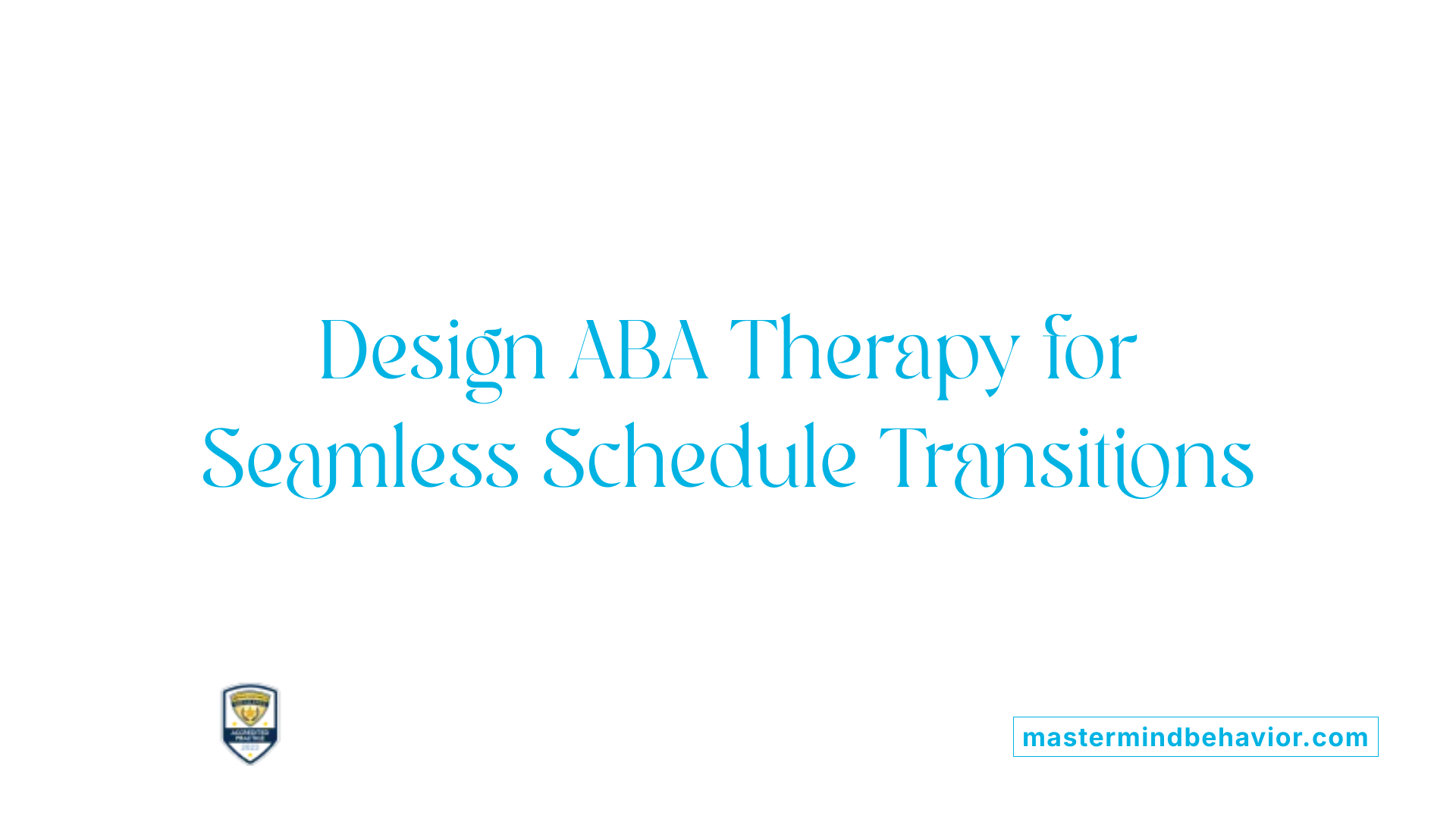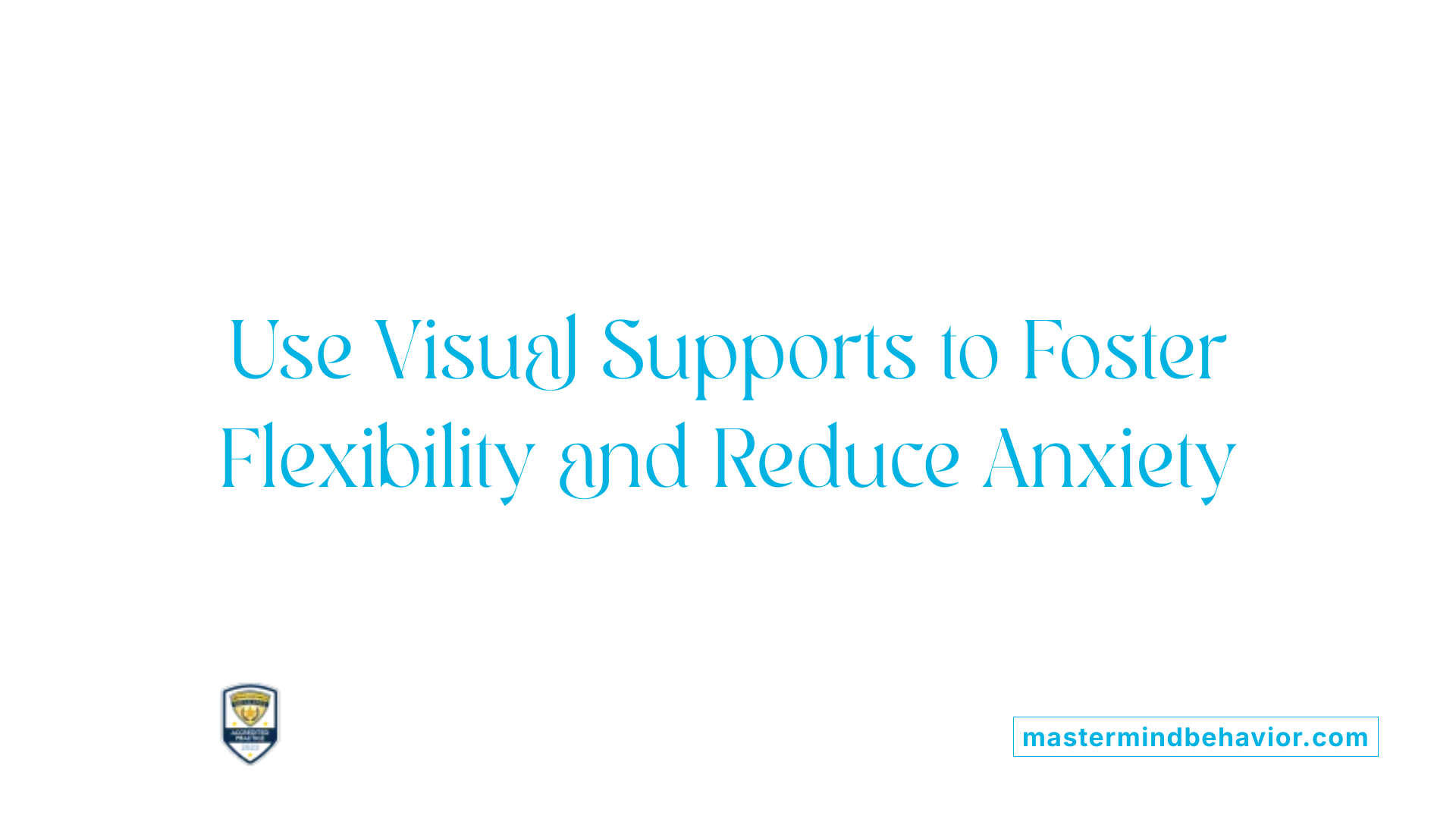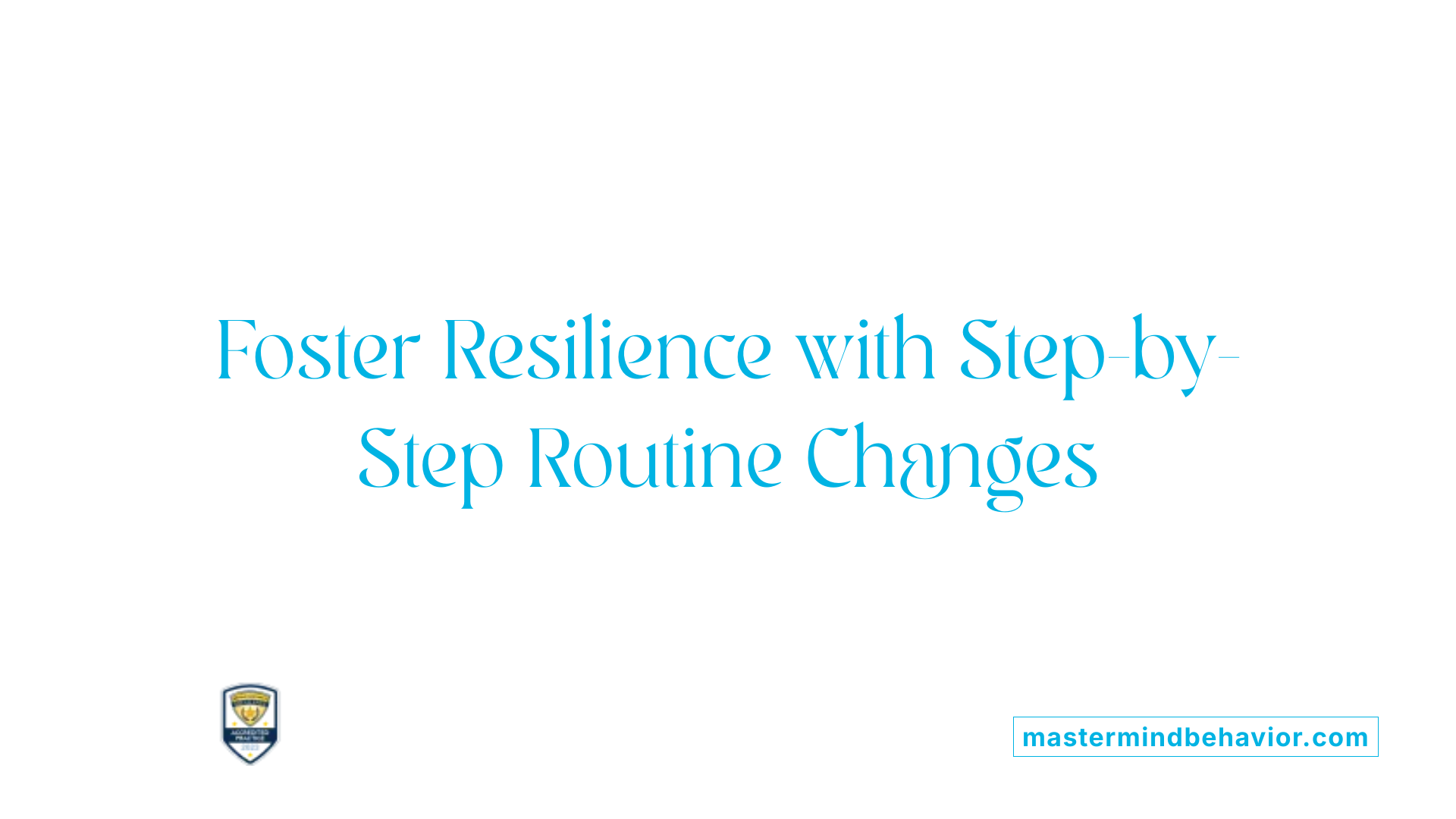ABA Therapy For Supporting Flexibility In Changing Schedules

Understanding ABA Therapy's Role in Flexibility
Applied Behavior Analysis (ABA) therapy is widely recognized for its effectiveness in helping individuals with autism develop essential skills and manage behaviors. A key area where ABA shows significant benefit is in supporting flexibility when routines and schedules change. For children on the autism spectrum, transitions and unpredictability can be challenging, often leading to distress and resistance. ABA therapy uses structured, evidence-based methods to teach adaptability, reduce anxiety, and encourage smooth transitions, creating more manageable and positive experiences during changes in daily life and routines.
What Is ABA Therapy and How Does It Support Individuals with Autism?
Definition and Goals of ABA Therapy
Applied Behavior Analysis (ABA) therapy is a science-based approach that applies principles of learning and behavior to assist individuals with autism. It focuses on understanding how environmental events influence behaviors through the antecedent-behavior-consequence (A-B-C) framework. The goal of ABA therapy is to teach important skills and reduce challenging behaviors by tailoring interventions to each person’s unique needs.
Individualized Behavior Analysis and Skill Development
ABA therapy programs are highly personalized and guided by qualified professionals such as Board Certified Behavior Analysts (BCBAs). Each program assesses the individual’s current abilities and designs targeted interventions to develop skills in key areas including communication, socialization, self-care, and academics. By analyzing behaviors methodically, therapists can identify effective strategies that promote positive development and independence.
Use of Positive Reinforcement and Prompting
A cornerstone of ABA is the use of positive reinforcement to strengthen desirable behaviors. This includes verbal praise, tangible rewards, or preferred activities following a target behavior, which encourages the child to repeat it. Prompting methods help guide individuals gradually towards the correct response, reducing frustration and fostering learning in a supportive manner.
Focus on Communication, Social Skills, and Self-Care
ABA therapy notably addresses critical life domains such as communication and social interaction, which are often challenging for individuals with autism. Interventions help develop functional communication skills, enhance social understanding, and teach self-care routines. This comprehensive focus supports overall growth and quality of life, preparing individuals to navigate daily living successfully.
Who Provides ABA Therapy and What Qualifications Do They Hold?
Who provides ABA therapy and what qualifications do these professionals have?
ABA therapy is delivered by trained professionals such as Board Certified Behavior Analysts (BCBAs), licensed therapists, and specialists with focused education in autism and behavior analysis. To qualify as a BCBA, an individual typically completes an undergraduate degree in psychology, education, or a related field, followed by a master's degree in applied behavior analysis or a similar discipline.
These professionals also must obtain certification and licensure through recognized bodies, which ensures they meet strict ethical, safety, and competency standards. Their training enables them to assess individual behaviors accurately, develop tailored intervention plans, and apply foundational ABA techniques like positive reinforcement and the A-B-C (Antecedent-Behavior-Consequence) model effectively.
ABA therapy providers operate in multiple environments, including clinics, hospitals, schools, community centers, and in-home settings. This variety allows therapy to be adapted to the child’s needs in familiar or supportive spaces.
When considering ABA services, verifying a provider’s credentials, qualifications, and experience is essential. This ensures that the therapy delivered is both effective and ethical, adhering to professional standards that foster safe and positive outcomes for children and families.
Structuring ABA Therapy to Promote Flexibility with Changing Schedules

How is ABA therapy typically structured and delivered to clients with autism?
ABA therapy for children with autism is centered on individualized treatment plans tailored to each child's unique needs. These plans are designed by professionals such as board-certified behavior analysts (BCBAs) and focus on specific behavioral goals and skill development.
Therapy sessions are usually conducted one-on-one or in small groups and take place in various settings, including clinics, homes, and schools. This multi-setting approach ensures that skills learned transfer across environments and everyday routines.
ABA employs the ABC model—Antecedent, Behavior, and Consequence—to analyze behaviors and apply positive reinforcement strategies that encourage desired behaviors. These reinforcements often include praise or tangible rewards that motivate children to engage smoothly in activities and transitions.
Techniques used to promote flexibility with changing schedules include gradual exposure to new routines, advance warnings about upcoming transitions, and the use of visual supports like picture schedules and timers. These tools create predictability and reduce anxiety, making changes in routine more manageable for children.
Ongoing assessment through data collection allows therapists to monitor progress and make necessary adjustments to intervention strategies. This continual adaptation ensures that therapy remains effective as children develop new skills and face different challenges.
By working collaboratively with families and schools, ABA therapy maintains consistency and generalization of skills, supporting children in adapting successfully to changing daily schedules while fostering independence and social growth.
The Science Behind ABA: Evidence Supporting Its Effectiveness
What is the evidence supporting the effectiveness of ABA therapy for autism?
ABA therapy, grounded in behavior analysis, is widely recognized as an effective intervention for autism spectrum disorder. Extensive research studies and meta-analyses have consistently demonstrated significant improvements in communication, social skills, and adaptive behaviors in children undergoing ABA therapy. These studies often use rigorous statistical methods such as multivariate analysis of covariance (MANCOVA) and report strong effect sizes, underscoring the therapy's impact across various developmental domains.
For example, comprehensive investigations involving diverse populations and settings—including institutionalized children in regions like Wuhan—offer robust empirical support for ABA's efficacy. These programs are highly individualized, employing positive reinforcement and the ABC (Antecedent-Behavior-Consequence) model to modify behaviors and foster skill development effectively.
The therapy shows especially pronounced benefits in areas such as IQ, language acquisition, and social interaction, with high effect sizes reported for long-term, intensive ABA interventions. These outcomes reflect key developmental milestones necessary for greater independence and quality of life.
Furthermore, ABA's effectiveness is globally acknowledged by leading health authorities, who endorse it as a standard treatment for autism. Early intervention with ABA amplifies these benefits, emphasizing the critical importance of timely therapy to improve long-term outcomes.
Given the considerable evidence base, ABA therapy continues to be a cornerstone of autism treatment, combining science-backed strategies to support children’s communication, social skills, and adaptive growth comprehensively.
Addressing Transition Challenges in Autism Through ABA Strategies
What Are Common Transition Difficulties in Children with Autism?
Children with autism often face challenges such as distress, resistance, and sensory overload during transitions between activities or environments. These difficulties can lead to meltdowns or behavioral outbursts, making transitions particularly stressful.
How Do Visual Supports Aid Transition Management?
Creating predictability through visual supports like picture schedules, First-Then boards, and timers helps children understand and anticipate changes in their routine. Visual cues provide a clear framework that reduces anxiety by making the sequence of events more concrete and manageable.
How Is Positive Reinforcement Used to Encourage Cooperation?
Positive reinforcement strategies, including verbal praise and tangible rewards, are effective in motivating children to transition smoothly. Reinforcing desired behaviors encourages repetition and builds positive associations with change.
What ABA Techniques Support Gradual Adaptation?
Gradual exposure to upcoming transitions, combined with advanced warnings and offering choices, helps children adjust at their own pace. These techniques reduce resistance and promote a sense of control over changes.
Why Is Maintaining a Calm Demeanor Important?
Therapists and caregivers who remain calm during transitions serve as emotional anchors for the child. A calm approach helps prevent escalation, reduces anxiety, and models appropriate coping mechanisms.
Together, these ABA strategies provide a comprehensive framework to support children with autism in navigating transitions more successfully, fostering skill development and emotional regulation.
Visual Supports and Tools to Enhance Flexibility and Predictability

Role of Visual Schedules Including First-Then Boards and PECS
Visual schedules are fundamental in ABA therapy for helping children with autism handle transitions smoothly. Tools like picture schedules, First-Then boards, and the Picture Exchange Communication System (PECS) provide clear, visual representations of daily activities. These aids foster understanding and create predictability, which is comforting for children who might otherwise find transitions distressing.
Use of Countdown Timers and Calendars
Countdown timers and calendars serve as effective tools to prepare children for upcoming changes. Timers allow kids to visually grasp how much time is left before an activity ends or a new one begins, helping them anticipate transitions. Calendars help to structure both daily and longer-term routines, providing stability even during less predictable periods, such as holidays or summer breaks.
Helping Children Anticipate and Understand Changes
Visual supports combined with social stories and gradual exposure help children anticipate and comprehend changes ahead of time. By introducing new routines or activities with visuals, children can process what to expect. This approach significantly decreases anxiety and prevents sensory overload related to sudden or unexpected transitions.
Reducing Anxiety and Sensory Overload Through Predictability
Creating a predictable environment with visual aids minimizes the stress children face during routine shifts. Predictability provided by visual schedules and planning not only reduces anxiety but also lessens resistance and emotional outbursts linked to sensory overload.
Engaging Children in Planning Routines Using Visuals
Involving children in creating their schedules with visual supports fosters a sense of control and reduces fears about changes. When children can see their day mapped out and participate in organization, they are more likely to transition smoothly and feel empowered.
Visual supports are essential in teaching flexibility while maintaining predictability, making transitions less daunting and enhancing overall routine management for children with autism.
Family, Therapist, and Caregiver Collaboration for Consistency
Why is teamwork important across home, school, and therapy settings?
Consistency in managing transitions is vital for children with autism. When families, therapists, and school caregivers work closely together, children experience a unified approach that minimizes confusion and anxiety. Coordination ensures that strategies learned in therapy are reinforced at home and school, promoting smoother adaptations during changes in routine.
How does training families in ABA methods help?
Training parents and caregivers in ABA techniques empowers them to confidently support their child’s transitions outside of therapy sessions. This training includes teaching the use of visual supports, positive reinforcement, and behavioral strategies that can be integrated into daily life, enhancing the child’s ability to handle routine changes effectively.
Why is consistency in applying strategies important?
Applying consistent strategies across environments reduces stress for the child and accelerates progress. When everyone involved uses similar visual schedules, timers, and reinforcement methods, it creates predictability, helping children feel secure and better prepared for transitions.
How do coordinated approaches impact progress and stress?
A collaborative plan developed by therapists, families, and schools helps maintain uniformity, reducing conflicting demands that can lead to distress or meltdowns. This teamwork also allows for flexibility, adapting routines during events like summer break while still maintaining therapeutic goals.
How can routines be incorporated during unpredictable periods like summer?
Summer often disrupts regular schedules, which can increase anxiety and behavioral issues. By maintaining structure through consistent use of visual supports and collaborating on flexible schedules, families and therapists ensure ongoing support. Incorporating preferred activities and balancing education with relaxation helps children enjoy summer while continuing to build skills.
| Aspect | Role of Families | Role of Therapists | Role of Caregivers/Schools |
|---|---|---|---|
| Training | Learn and apply ABA strategies | Provide training and resources | Support consistent implementation |
| Consistency | Use visual schedules and reinforcement | Design individualized plans | Reinforce routines and expectations |
| Communication | Share daily progress and concerns | Adjust strategies based on feedback | Collaborate to ensure smooth transitions |
| Managing Unpredictability | Maintain routines during breaks | Adapt therapy sessions flexibly | Assist in maintaining school routines |
| Emotional Support | Offer comfort and prepare for change | Teach coping strategies | Provide stable environment |
Incorporating Flexibility in Summer and Holiday Schedules

Maintaining Structure During Breaks to Reduce Anxiety
Summer breaks and holidays often disrupt children’s usual routines, which can increase anxiety and behavioral challenges for children with autism. Maintaining a consistent environment and structured routines during these times helps provide stability and comfort. Creating visual schedules and calendars outlining daily activities reduces uncertainty and supports smoother transitions. This predictability is crucial in helping children feel secure despite the changes in their daily life.
Balancing Educational, Social, and Leisure Activities
Effective summer and holiday routines strike a balance between educational tasks, social opportunities, and relaxation. Including preferred activities and outings ensures children stay engaged and motivated. Educational activities can be combined with social playdates or structured outings, followed by leisure time to rest and recharge. This balanced approach not only supports developmental growth but also enhances enjoyment and reduces stress during unstructured periods.
Flexible Scheduling of In-Home and School ABA Therapy
ABA therapy can continue over summer and holidays through flexible scheduling that accommodates family plans and outings. In-home ABA sessions offer the advantage of providing therapy in a familiar environment, which can facilitate comfort and learning retention. School-based programs and therapists can collaborate with families to adjust session timings, ensuring consistency in therapeutic goals without overwhelming the child.
Adjusting Therapy Sessions for Outings and Vacations
Adapting therapy around planned outings or vacations helps children maintain progress while enjoying new experiences. Therapists employ strategies such as gradual exposure to novel environments and using visual supports to prepare children for changes. With advance planning, parents and therapists can create contingency schedules and use portable visual aids to manage transitions effectively during trips.
Using Home-Based ABA to Reinforce Skills in Familiar Environments
Home-based ABA therapy during summer serves as an excellent platform to reinforce positive behaviors and teach new skills within contexts the child knows well. This familiar setting aids in generalizing learned behaviors across environments and supports independence. Parents encouraged to involve children in planning their daily routines with visual supports promote autonomy and reduce anxiety linked to change.
Together, these flexible yet structured approaches enable children with autism to enjoy summer and holiday periods while continuing to build essential skills and manage transitions smoothly.
Teaching Communication and Emotional Regulation for Better Adaptability

Encouraging Use of Alternative Communication Methods
Children with autism often benefit significantly from alternative ways to communicate, especially when navigating transitions. Tools like picture cards, sign language, and assistive communication devices empower children to express their needs and feelings effectively.
Role of Picture Cards, Sign Language, and Assistive Devices
Picture cards provide clear visual cues that make abstract feelings or requests concrete. Sign language offers an accessible manual form of communication, which is useful when verbal speech is limited. Assistive devices, such as speech-generating devices, further enhance communication, helping children convey complex ideas and emotions.
Helping Children Express Needs and Feelings About Change
When children can communicate their anxieties or preferences about upcoming changes, they feel more in control. This reduces frustration and supports smoother transitions. Using these communication aids, they can indicate when they need a break or express concerns about new routines.
Supporting Emotional Regulation During Transitions
Effective communication tools allow caregivers and therapists to recognize emotional distress early. This recognition facilitates timely interventions through calming strategies or adjustments in the environment, preventing meltdowns and easing anxiety.
Impact on Reducing Behavioral Challenges Related to Schedule Changes
By fostering clear expression and emotional understanding, alternative communication methods directly reduce behavioral challenges related to schedule changes. Children learn to adapt better, with less resistance and distress, making routine transitions less disruptive and more manageable overall.
Building Adaptability Through Small, Gradual Changes in Routine

Why Introduce Changes Gradually?
Introducing small, gradual changes helps children with autism adjust more comfortably to new routines. Sudden shifts can cause distress, resistance, and even sensory overload, common challenges during transitions. Gradual changes reduce anxiety by allowing the child to acclimate step-by-step without feeling overwhelmed.
How Are Social Stories and Preview Visits Used?
Social stories are short, personalized narratives that explain upcoming changes in simple terms, preparing children emotionally and cognitively. Preview visits to new environments provide hands-on exposure before full engagement, making new settings less intimidating and more familiar.
Teaching Tolerance and Embracing Change
ABA therapy uses techniques like visual supports, warning signals, and choice-making to help children tolerate and later embrace change. These methods teach coping skills and increase comfort with variability in daily activities.
Impact on Distress and Behavioral Outbursts
By gradually introducing changes and using supportive strategies, children experience fewer meltdowns and behavioral disruptions. This approach promotes smoother transitions, reducing anxiety and resistance during routine shifts.
Promoting Long-Term Flexibility and Independence
Building adaptation skills early helps children develop lifelong flexibility. This growth fosters independence, allowing them to manage transitions across different environments, enhancing social skills and participation in various daily routines.
| Strategy | Description | Benefit |
|---|---|---|
| Gradual Changes | Introducing routine adjustments stepwise | Minimizes anxiety and sensory overload |
| Social Stories | Personalized narratives explaining changes | Prepares children emotionally |
| Preview Visits | Exposure to new environments before engagement | Reduces fear and unfamiliarity |
| Visual Supports | Tools like timers and First-Then boards | Clarifies expectations |
| Positive Reinforcement | Praise and rewards for adapting to change | Encourages acceptance and learning |
This section highlights that ABA strategies centered on gradual and supported change help children with autism build resilience and adaptability in daily life.
Supporting Children with Autism Through Changing Schedules
Flexibility in schedules and routines is a critical skill for children with autism, helping them adapt to the unpredictabilities of daily life. ABA therapy provides a structured yet adaptable framework to teach this skill, combining individualized behavior analysis with proven strategies like visual supports, positive reinforcement, and collaborative consistency among caregivers and professionals. With ample scientific evidence highlighting its effectiveness, ABA enables children to transition smoothly, manage anxiety, and develop independence. By integrating these approaches across home, school, and community environments — especially during periods of change such as summer breaks — ABA therapy strengthens the foundation for children to thrive amid the shifts and challenges in their lives.
References
- Effective ABA for Managing Transitions in Kids
- Home-Based Therapy for Summer brake in Children ...
- Helping Kids with Autism Adapt to Routine Changes
- Applied Behavior Analysis (ABA)
- How to Become an Applied Behavior Analyst (ABA) Therapist
- Applied Behavior Analysis (ABA)
- Applied Behavior Analysis (ABA)
Recent articles

ABA Therapy Strategies For Developing Resilience To Criticism
Building Emotional Strength: ABA Approaches to Nurturing Resilience in Children with Autism

ABA Therapy For Building Resilience To Change
Harnessing ABA Therapy to Foster Adaptability and Emotional Strength in Children with Autism

Teaching Planning And Organization With ABA Tools
Enhancing Independence Through Structured ABA Strategies

Teaching Planning And Sequencing Using ABA Therapy
Enhancing Learning and Life Skills Through ABA-Based Planning and Sequencing

How ABA Therapy Encourages Healthy Risk Assessment Skills
Enhancing Decision-Making and Safety Awareness Through ABA Therapy

How ABA Therapy Improves Classroom Group Participation
Enhancing Classroom Dynamics Through Applied Behavior Analysis



